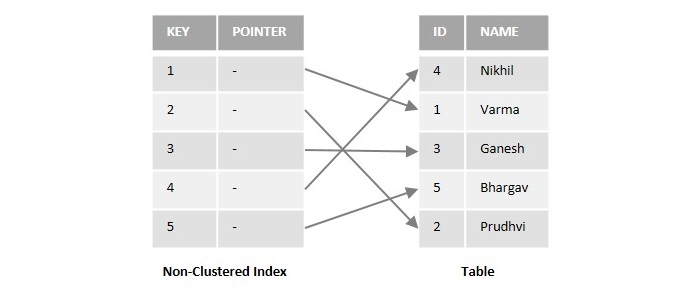SQL Non-Clustered Indexes
The SQL Non-Clustered index is similar to the Clustered index. When defined on a column, it creates a special table which contains the copy of indexed columns along with a pointer that refers to the location of the actual data in the table. However, unlike Clustered indexes, a Non-Clustered index cannot physically sort the indexed columns.
Following are some of the key points of the Non-clustered index in SQL −
- The non-clustered indexes are a type of index used in databases to speed up the execution time of database queries.
- These indexes require less storage space than clustered indexes because they do not store the actual data rows.
- We can create multiple non-clustered indexes on a single table.
MySQL does not have the concept of Non-Clustered indexes. The PRIMARY KEY (if exists) and the first NOT NULL UNIQUE KEY(if PRIMARY KEY does not exist) are considered clustered indexes in MySQL; all the other indexes are called Secondary Indexes and are implicitly defined.
To get a better understanding, look at the following figure illustrating the working of non-clustered indexes −

Assume we have a sample database table with two columns named ID and NAME. If we create a non-clustered index on a column named ID in the above table, it will store a copy of the ID column with a pointer that points to the specific location of the actual data in the table.
Syntax
Following is the syntax to create a non-clustered index in SQL Server −
CREATENONCLUSTEREDINDEX index_name ON table_name (column_name)
Here,
- index_name: holds the name of non-clustered index.
- table_name: holds the name of the table where you want to create the non-clustered index.
- column_name: holds the name of the column that you want to define the non-clustered index on.
Example
Let us create a table named CUSTOMERS using the following query −
CREATETABLE CUSTOMERS( ID INTNOTNULL, NAME VARCHAR(20)NOTNULL, AGE INTNOTNULL, ADDRESS CHAR(25), SALARY DECIMAL(20,2),);
Let us insert some values into the above-created table using the following query −
INSERTINTO CUSTOMERS VALUES(7,'Muffy','24','Indore',5500),(1,'Ramesh','32','Ahmedabad',2000),(6,'Komal','22','Hyderabad',9000),(2,'Khilan','25','Delhi',1500),(4,'Chaitali','25','Mumbai',6500),(5,'Hardik','27','Bhopal',8500),(3,'Kaushik','23','Kota',2000);
The table is successfully created in the SQL database.
| ID | NAME | AGE | ADDRESS | SALARY |
|---|---|---|---|---|
| 7 | Muffy | 24 | Indore | 5500.00 |
| 1 | Ramesh | 32 | Ahmedabad | 2000.00 |
| 6 | Komal | 22 | Hyderabad | 9000.00 |
| 2 | Khilan | 25 | Delhi | 1500.00 |
| 4 | Chaitali | 25 | Mumbai | 6500.00 |
| 5 | Hardik | 27 | Bhopal | 8500.00 |
| 3 | Kaushik | 23 | Kota | 2500.00 |
Now, let us create a non-clustered index on a single column named ID using the following query −
CREATENONCLUSTEREDINDEX NON_CLU_ID ON customers (ID ASC);
Output
On executing the above query, the output is displayed as follows −
Commands Completed Successfully.
Verification
Let us retrieve all the indexes that are created on the CUSTOMERS table using the following query −
EXEC sys.sp_helpindex @objname= N'CUSTOMERS';
As we observe, we can find the column named ID in the list of indexes.
| index_name | index_description | index_keys | |
|---|---|---|---|
| 1 | NON_CLU_ID | nonclustered located on PRIMARY | ID |
Now, retrieve the CUSTOMERS table again using the following query to check whether the table is sorted or not −
SELECT*FROM CUSTOMERS;
As we observe, the non-clustered index does not sort the rows physically instead, it creates a separate key-value structure from the table data.
| ID | NAME | AGE | ADDRESS | SALARY |
|---|---|---|---|---|
| 7 | Muffy | 24 | Indore | 5500.00 |
| 1 | Ramesh | 32 | Ahmedabad | 2000.00 |
| 6 | Komal | 22 | Hyderabad | 9000.00 |
| 2 | Khilan | 25 | Delhi | 1500.00 |
| 4 | Chaitali | 25 | Mumbai | 6500.00 |
| 5 | Hardik | 27 | Bhopal | 8500.00 |
| 3 | Kaushik | 23 | Kota | 2500.00 |
Creating Non-Clustered Index on Multiple Columns
Instead of creating a new table, let us consider the previously created CUSTOMERS table. Now, try to create a non-clustered index on multiple columns of the table such as ID, AGE and SALARY using the following query −
CREATENONCLUSTEREDINDEX NON_CLUSTERED_ID ON CUSTOMERS (ID, AGE, SALARY);
Output
The below query will create three separate non-clustered indexes for ID, AGE, and SALARY.
Commands Completed Successfully.
Verification
Let us retrieve all the indexes that are created on the CUSTOMERS table using the following query −
EXEC sys.sp_helpindex @objname= N'CUSTOMERS';
As we observe, we can find the column names ID, AGE and SALARY columns in the list of indexes.
| index_name | index_description | index_keys | |
|---|---|---|---|
| 1 | NON_CLU_ID | nonclustered located on PRIMARY | ID, AGE, SALARY |